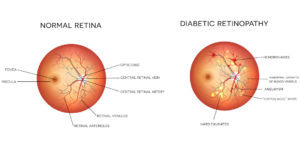Diabetic Eye Disease
People living with diabetes should have eye screening as part of their diabetes checks. This is because diabetes can lead to eye problems, such as diabetic retinopathy.
 The development of diabetic retinopathy (DR) occurs in nearly all persons with diabetes and remains a leading cause of blindness worldwide. Despite the availability of highly effective treatment for the sight-threatening complications of diabetes, many persons with diabetes do not receive regular eye care examinations and sight-preserving treatments.
The development of diabetic retinopathy (DR) occurs in nearly all persons with diabetes and remains a leading cause of blindness worldwide. Despite the availability of highly effective treatment for the sight-threatening complications of diabetes, many persons with diabetes do not receive regular eye care examinations and sight-preserving treatments.
Moreover, not all patients achieve the levels of glycemic control demonstrated to reduce the risk of retinopathy in both type 1 and type 2 diabetes. Early detection through screening programs and appropriate referral for therapy are important to preserve vision in individuals with diabetes.
RATIONALE FOR SCREENING
The onset of diabetic retinal complications is typically insidious, and patients remain generally asymptomatic and unaware of the disease during the early stages when treatment and medical management are most effective. The asymptomatic presentation of DR emphasizes the importance of retinal examinations to detect and evaluate disease severity and identify patients at risk for vision loss. The rate of DR progression may be rapid, and therapy can be beneficial for both symptom amelioration and reduction in the rate of disease progression.
METHOD OF SCREENING
Initial screening can be accomplished with dilated fundus examination or retinal photography.

